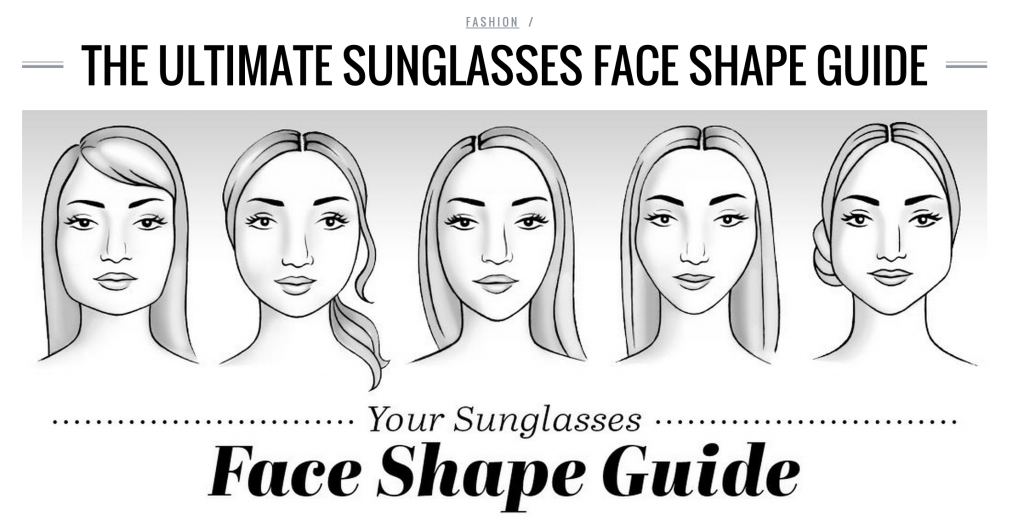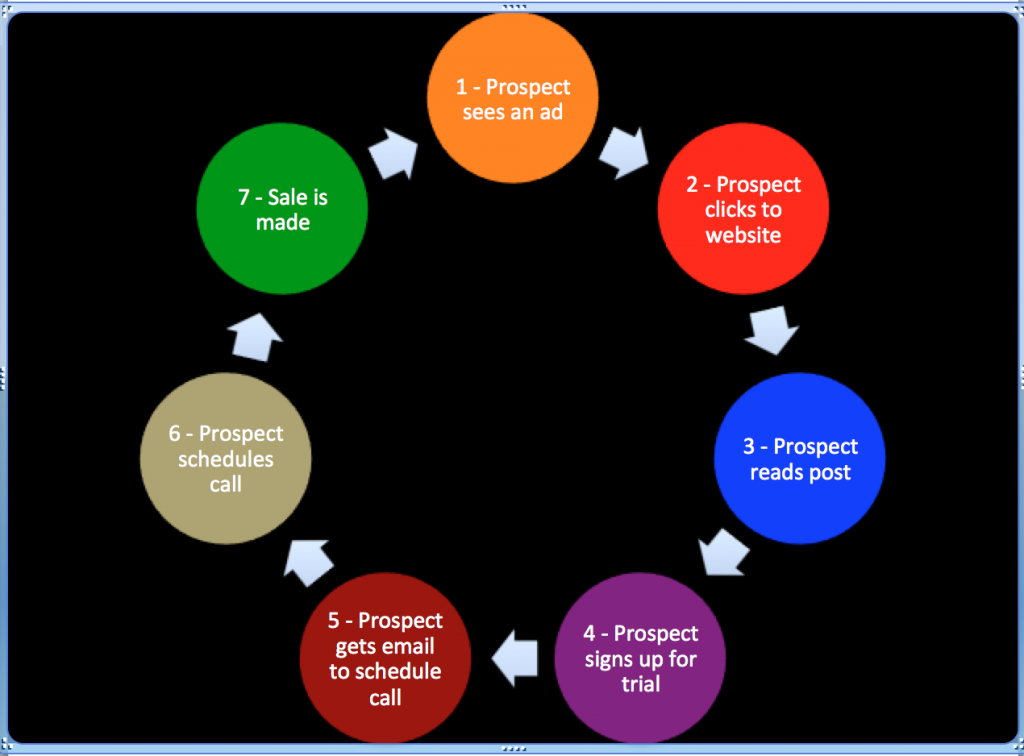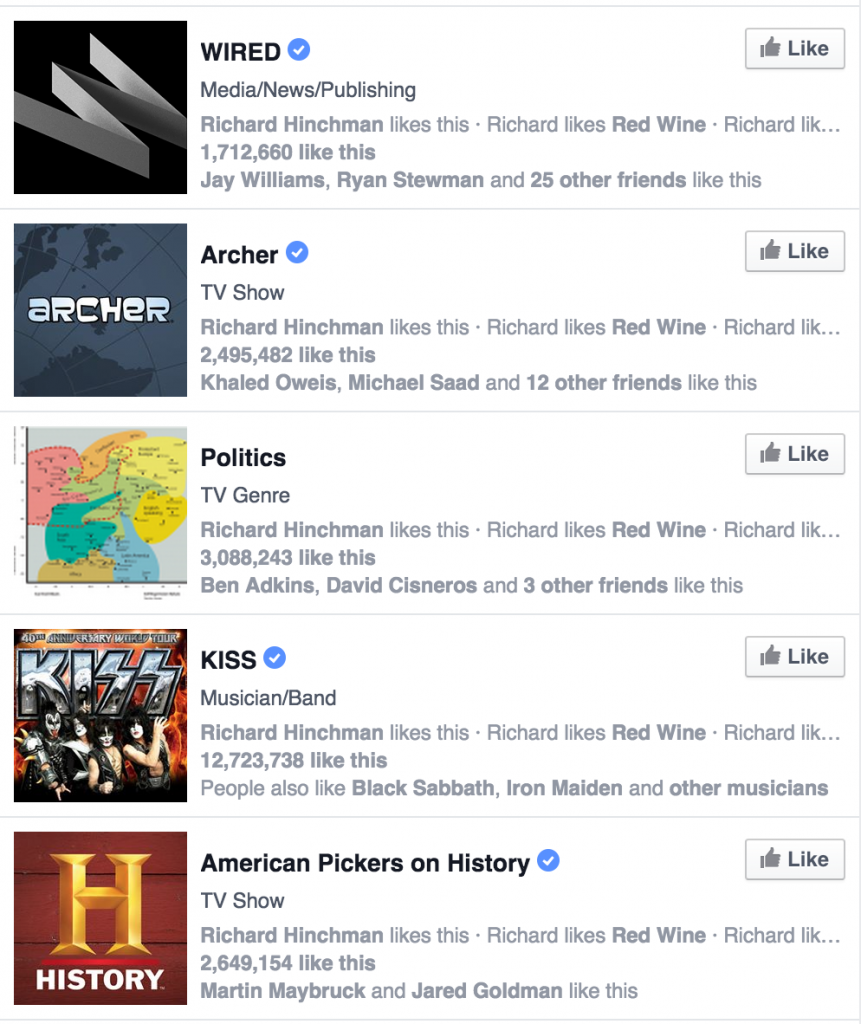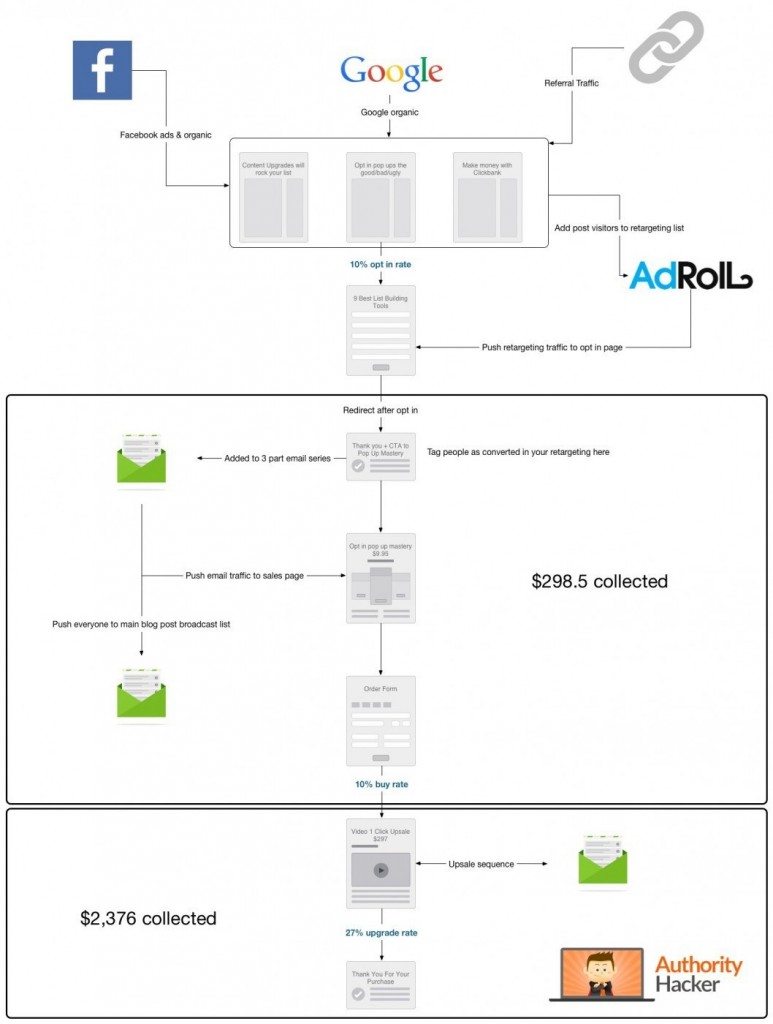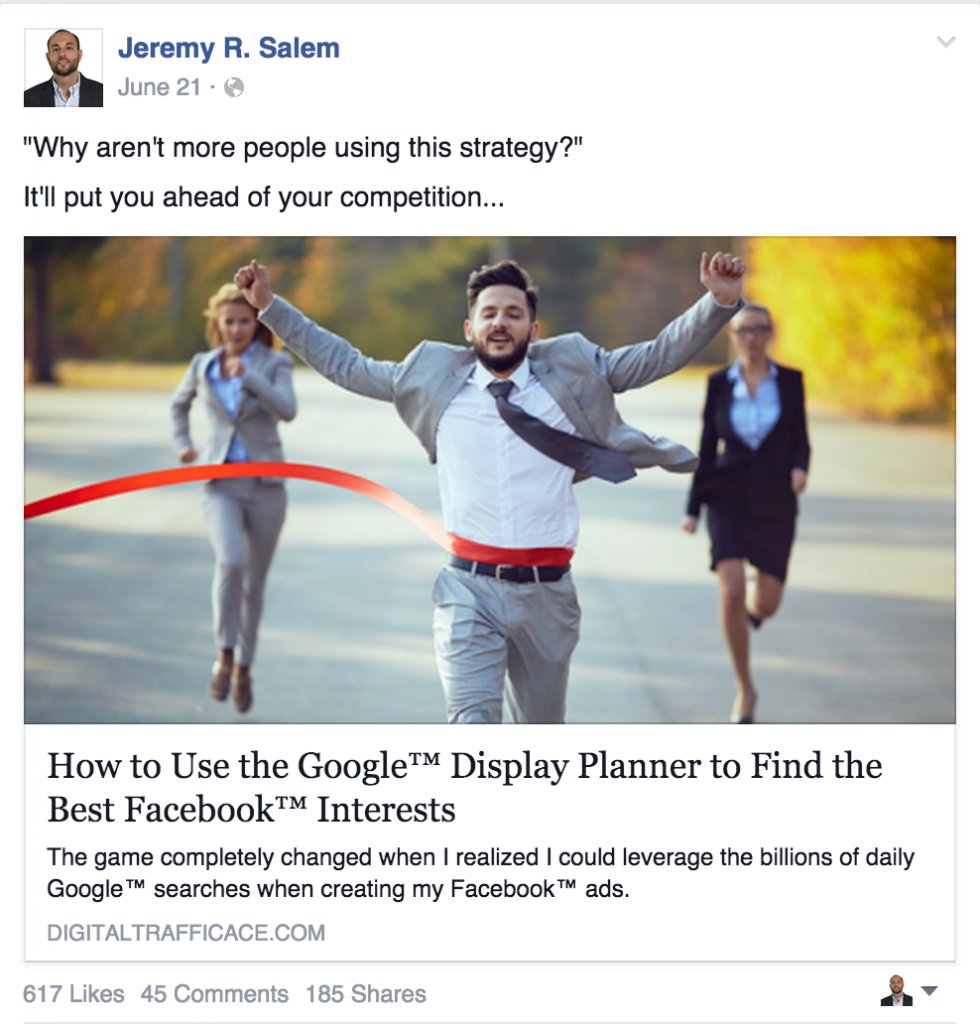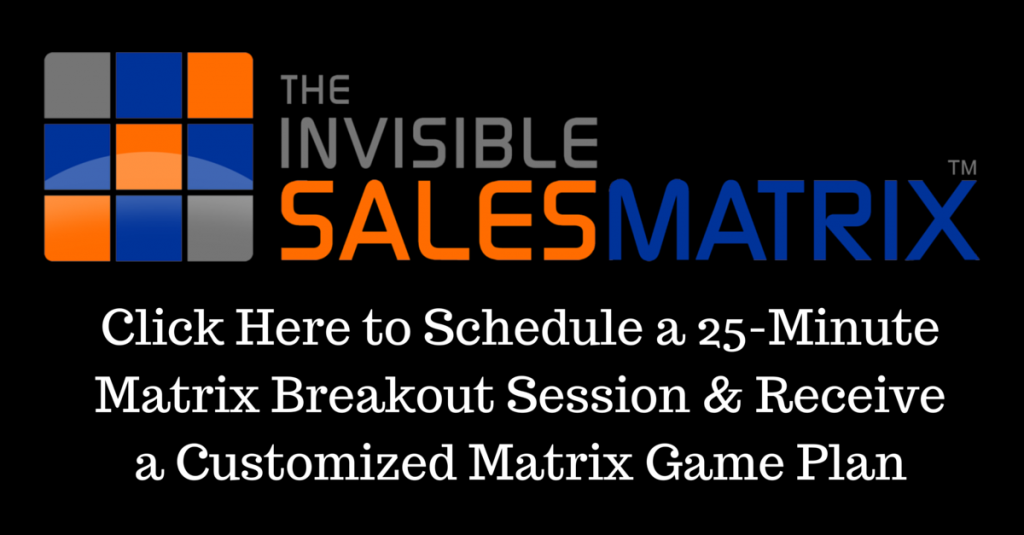It all starts here…
You’ve just stumbled upon my most precious resource…
The roadmap that can INSTANTLY take your business to new heights you previously thought were unattainable.
Let me ask you a question…
Are you sick of blending in with everyone else?
Wanna learn how to setup a system that brings you hundreds of leads per week, all while becoming an AUTHORITY in your industry and a hero in your marketplace?
If so, let me introduce you to my friend…
While Digital Traffic Ace covers a lot of different aspects of online marketing, The Invisible Sales Matrix is the fundamental blueprint I use to grow my business on a daily basis.
This post is nearly 5000 words long. Click here to get a 1-page Cheat Sheet of this entire strategy.
There is tons of info out there about Facebook marketing, list building, content, and more — but all that stuff does you no good if you don’t have a strategy in place to tie it all together.
That’s what The Invisible Sales Matrix is all about — it’s my 8-step proprietary formula that turns strangers into visitors, visitors into leads, and leads into customers — all while establishing your brand and building goodwill in your marketplace.
And it’s done by combining paid advertising with content marketing, and turning your online presence into a lead generating machine.
And I’ve got good news — after reading this post, you’ll know how to build the same type of machine in your business.
It doesn’t matter who you are, what you’re selling, what your price points are, or what platform you’re advertising on.
This formula will give you an edge in your marketplace…
Here’s Why This Formula Works
It’s actually been used for centuries – just not quite like this…
It’s the same strategy used by car dealerships, event speakers, home builders, newspaper advertisers, timeshare companies, and more.
Ever been browsing a newspaper and seen an advertisement like this?
One of the reasons advertisements like this are effective, is because they blend in with the platform they are featured in.
But the main reason it works is because it’s based on three proven principles of human psychology:
1) If you give someone something of value and genuinely help them, without asking for anything in return, they’re more likely to trust you.
2) If you can manage to create a “buzz” in your marketplace and make yourself stand out, people are more likely to view you as an authority.
3) If you can manage to pique someone’s interest, there’s a good chance they’ll want to learn more about your product or service.
Let’s take a look at a very simple example…a home builder.
They build a new community and have a “Grand Opening” celebration. It includes food, drinks, bounce houses for the kids, and helpful team members who will show you around the model homes and answer your questions.
They aren’t coming right out and saying, “Hey, buy one of our homes.”
They are giving you value in advance by helping you in your decision-making process.
This satisfies rule #1 listed above.
Along with that, their “Grand Opening” has created a neighborhood buzz. Everyone is talking about the new community, the clubhouse at the front, and all the other amenities.
The home builder is now viewed as an authority — people start to think, “Now THIS is the place to live!”
This satisfies rule #2 listed above.
On top of that, the home builder is talking about the state-of-the-art kitchen cabinets, bathroom tile, patio, and clubhouse pool.
They are piquing the interest of potential home buyers, and making them want to learn more.
This satisfies rule #3 listed above.
When you combine all these rules, you have created an “invisible” sales effect.
People begin to want to buy, without you even having to sell.
Now, if you do begin to try and sell, people are more likely to hear you out.
They are more willing to listen, because they have voluntarily entered the sales process, and weren’t ‘forced’ into it.
This makes the entire sales process a whole lot easier.
With The Invisible Sales Matrix, we are taking this same formula, but applying it ONLINE, where we have the ability to create multiple touch points and maximize the process!
Strapped for time? Click here to get a 1-page Cheat Sheet of this entire strategy.
There Are 2 Main Ways to Sell Your Product or Service
Every business has a choice – they can sell their product or service using…
- Outbound Marketing (aka “Interruption Marketing”) – This could be knocking on doors, direct mail, cold calling, trade shows, or anything similar.
- Inbound Marketing (or what I like to call, “Attraction Marketing”) – This is when you create value for your target audience, establish your authority, and pique their interest.
“Attraction Marketing” is the guiding principe of The Invisible Sales Matrix.
However, the key to the whole strategy is the “invisible” piece.
When using “Attraction Marketing,” you need to blend in with whatever platform you’re using to reach your target audience.
You may hear people talk about this advertising strategy, but you see very few people actually doing it.
This is the guiding principle in my business.
Let’s look at another example…
If you’re like most people, you probably wear sunglasses from time to time.
Now there may be times where you actively go out looking to buy sunglasses.
But in this example, let’s assume summer is right around the corner, and you know you’ll be spending some time at the beach.
You aren’t actively looking to buy new sunglasses, but as you surf the internet, you see an ad:
Nothing odd about this — a typical advertisement.
I’m not saying this is good or bad…
But, let’s say you continue surfing the web, and then see this:
It’s a blog post / info graphic that shows how all people have different shaped faces, and how certain sunglasses fit certain facial shapes better than others.
It then lists out different sunglass options for each facial shape and you can click on those and buy.
Do you see how the second type of “advertising” is more appealing than the first?
It’s because it’s not really “advertising” at all…
You may click on the face shape guide, find YOUR facial shape, and then begin browsing the sunglasses that would best fit you.
Now there are many more aspects involved — email capture, follow-up, retargeting, etc — but this is “invisible” marketing at it’s core.
Once you learn how to incorporate this principle into your business, you’ll never have to “sell” again.
Take some time to read this page and the steps to successfully launch The Invisible Sales Matrix in your own business.
Your business will thank you.
Here’s a Step-By-Step Breakdown of the Invisible Sales Matrix
(Note: There are various action-items involved with each step of the process, but below I have outlined what you should look to accomplish in each phase of the formula.)
Step 1: Funnel Formation
Do you remember as a kid, those old TV shows or movies where the characters would go into the forest, and to make sure they didn’t get lost, they’d leave footprints to find their way back?
I call this the Forest Footprints Formula, and it’s the driving mechanism behind the first step in The Invisible Sales Matrix.
In virtually every marketing campaign, you need to start with the end in mind.
What does that mean, exactly?
You cannot put together The Invisible Sales Matrix if you don’t know what path you want to take your leads and customers on.
So in the Funnel Formation step, we work backwards to identify what actions we ultimately want our visitors and leads to take at each step of our sales process.
This is how you make sure your entire funnel is congruent, and each step seamlessly leads to the next.
There is a formula to do this, and many pieces involved, but to make this easier to understand, let’s look at an example.
Let’s say your end goal is to get a prospect on the phone and sell them your product or service.
(FYI: The end result is interchangeable with your business goals. It could be to make a sale off a webinar, to sell an eBook, to sell a product in your online store, etc.)
Your Funnel Formation may look like this:
It’s important to note that this is a very simple example of a Funnel Formation, but it gets the point across.
In this example, we haven’t touched on ads, email sequences, retargeting, or anything else.
That’s okay, because the main thing you need to understand in this step is that forming your sales funnel has to happen before anything else can take place.
Step 2: Audience Attainment
At this point, you’ve mapped out how someone goes from a stranger to a visitor, a visitor to a lead, and a lead to a customer.
But as you know, mapping it out and making it happen are two COMPLETELY different things.
To get yourself started on the right path, you must be certain you’re targeting the right people.
Going back to the home builder example…
If the neighborhood you’ve built has a kid’s playground and consists of 4000 square foot homes with a pool, then you probably want to make sure your advertising dollars go towards reaching families, and not the singles market.
You need to be certain your putting the first step of your Funnel Formation in front of your desired target audience.
Social media platforms have simplified this process over the last few years.
For example — on Facebook, I can target people by websites they visit, influencers they follow, books they read, softwares they use, job titles, employers, and more.
If I want to find Facebook pages liked by men who are over 30 years old, and who like the movie My Cousin Vinny, and drink Red Wine, I can do that!
And Facebook will tell me what else those people like, so I can find more people just like them:
There is a detailed blueprint I go through to really narrow down my target audience, but the main takeaway here is to make sure your advertising and marketing is dangled in front of the people you’ve identified as target customers.
Step 3: Covert Content
If I had to sum this step up in 6 words…
This is where the magic happens!
You may have heard “Content is King,” and indeed it is when used correctly.
In the third step, we create content that will be a MAGNET to our target audience.
This is where the attraction really comes into play.
And I’m not talking about putting together a typical landing page and lead magnet — I’m talking about creating content that makes your target audience salivate for more.
It’s content that stops them in their tracks…
Content that is like their favorite TV show, where they just can’t turn it off.
They HAVE to see what happens next.
And the amazing thing (to them), is it’s content that’s completed free and easily accessible.
Stuff they probably would have paid for under different circumstances…
Assuming you get the point, the logically question is, how do we create this type of content?
This would need to be an entire post or product within itself, but below I have summarized the different mechanisms I deploy to create content my target audience craves:
- “Me Too” Formula
- Forbes Tie-in
- Celebrity Association
- In-Depth Explanations
- Box, Pop, Grab Strategy
- Puzzle Disassembly
Each of these plays a different role in creating content that will attract your target audience and encourage them to take action.
As I said above, I can’t go deep into each of these, but when creating content, think of what will catch your target audiences attention and give the most value to them.
It could be a case study…
Or a step-by-step walkthrough…
Or a how-to guide…
Or a story that ties into a larger point.
There are multiple types of content you can create, and once you determine what that content is, think of how you could logically tie in the next step.
That’s the key to making this work effectively!
(Newsflash: One really good piece of content can take you a long way and can be used for months and months to generate leads. Taking the time to write one epic and remarkable content piece will generate you far more leads long term than a bunch of simple and fluffy blog posts.)
Like what you’re reading? Click here to get a 1-page Cheat Sheet of this entire strategy.
Let’s look at an example…
One of my favorite websites to read about blogging, content marketing, and more is Boost Blog Traffic.
If you visit their website, you’ll notice tons of great posts — but here’s one I recently read:
If you blog or write content for your website, this is an intriguing post.
Boost Blog Traffic has done a great job identifying their exact target audience, and then speaking to them and providing tremendous value.
If I’m someone looking for ways to generate better content, then this post will attract me.
Towards the bottom of the post, there is an offer made to give the reader additional help and resources:
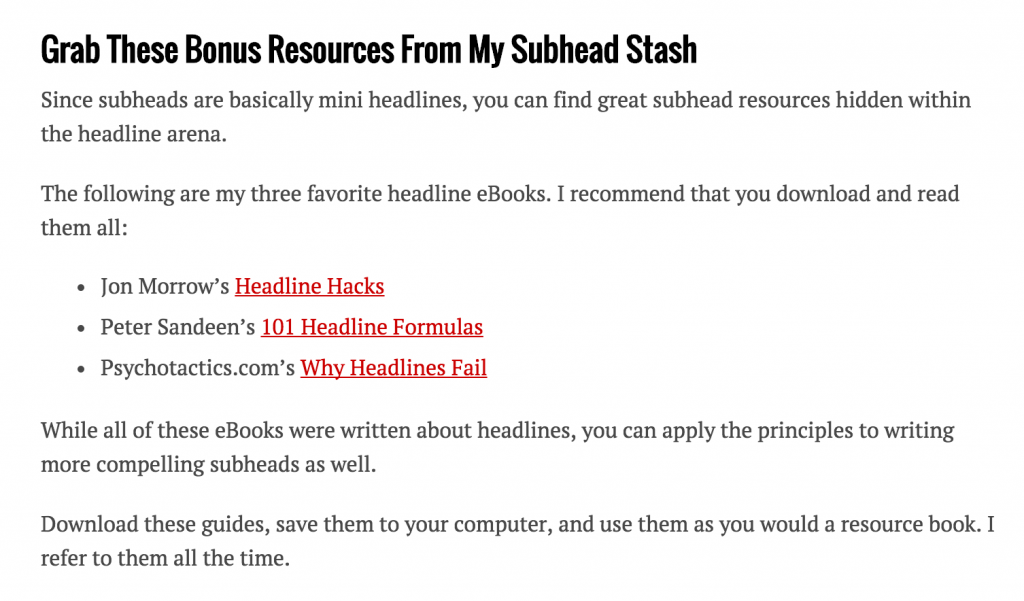 This is what you call the next logical step.
This is what you call the next logical step.
The prospect has read your content, and now you give them the opportunity to download additional resources.
(Note: In this example, Boost Blog Traffic is actually giving you three additional resources, but only the top one is their actual resource. This is a great way to show your audience you have their best interests in mind, and aren’t just promoting your own stuff.)
If I click the top resource guide, I’m taking to a landing page to download the guide:
See how that works?
The content in the blog post was designed to be extremely valuable, and make people want more.
Then inside that blog post, you offer the reader an opportunity to take the next logical step.
Now you’ve captured that lead and can continue to take them through your funnel.
This process may seem simple, but it’s only effective if tied in to the larger strategy!
IMPORTANT: The next logical step you offer the reader MUST be related to the content your prospect is currently reading.
Let’s take a look at another quick example — this one from my friend Ryan Stewmann (aka The Hardcore Closer).
This is a good example, because Ryan’s funnel is really simple:
Get someone to fill out an application > Get that person on the phone > Close them.
Here’s one of Ryan’s recent blog posts:
And then once you’re done reading, he presents the next logical step:
Will everyone who reads his post fill that form out and schedule a call?
Of course not.
That’s why we’re putting an entire system in place — to maximize each step of our lead generation process.
If you read my blog, start taking notice of the way I use my content.
I don’t just write for the sake of writing.
Everything is done for strategic purposes…
Just remember, the big takeaway is that your Covert Content needs to make your prospects take the next logical step in your sales process.
That is it’s #1 priority.
Remember earlier in our Funnel Formation example above, where we wanted our target prospect to sign up for a free trial?
In that example, our Covert Content may consist of a step-by-step walkthrough on how to complete a difficult project.
In that case, what would be a logical next step?
Perhaps our software takes that entire step-by-step process and automates it for your target prospect.
Since you went through the Funnel Formation in Step 1, you would have logically designed your funnel so that the target prospect reads the step-by-step walkthrough, and then is offered the ability to automate that process by using a free trial of your software.
Makes sense, right?
You’ve given yourself the best opportunity to get them to sign up for the free trial, because you setup your funnel properly from the beginning, gave the prospect value, and then asked them to take the next logical step.
I hope the power of this is beginning to sink in…
Step 4: Sequential Setup
Out of all the elements involved in The Invisible Sales Matrix, this step is arguably the most important in terms of the return on investment you’ll see long term.
In the Sequential Setup, you ensure each piece of your funnel benefits the next.
This step is often confused with “retargeting.”
Yes, retargeting is an essential piece of a proper Sequential Setup.
But it’s so much more than that…
In the Sequential Setup, you first want to make sure you have all the right tracking and pixels in place.
If the words “tracking” and “pixels” scare you, don’t worry.
It’s actually really simple.
You just want to put parameters in place, so you know where each person is at every stage of your funnel, and can sequentially speak to them based on the actions they have or haven’t taken.
This way, once you turn on your marketing campaigns, every thing is setup properly and your prospects will smoothly transition from one step to the next.
On the advertising side, we do this using two mechanisms:
- The “You Recently” Framework
- The Exclusion Principle
Beyond making sure the right message is shown to the right person at the right time, the Sequential Setup also involves making sure you have your backend setup correctly.
The right email sequences ready to go out to people…
The right campaigns setup to easily identify the people who have taken certain actions and those who haven’t…
And more.
This is why I said before that this step is arguably the most important in terms of your long-term return on investment.
Most people invest in advertising and hope their prospect will take all the desired actions right away.
But you and I know better than that…
Take a look at a promotion I’m currently running to people who read a piece of my content, but didn’t initially take my next logical step (I wanted them to download one of my lead magnets):
This is over a 7 day span.
As you can see, I’ve generated 491 new leads for an average cost of $1.47 per lead.
This post is nearly 5000 words long. Click here to get a 1-page Cheat Sheet of this entire strategy.
(Note: For the sake of transparency, I have also spent money on promoting the initial post that these people read. Many people downloaded my lead magnet directly from that post, but this ad was run only to those that did not. Total leads generated from the post is 989, many of which have become buyers of my products and services.)
By having this setup in place, we can maximize each person we send through our funnel, and seamlessly transition them from one step to the next.
While the Sequential Setup design will differ a bit for each business, the great marketers over at Authority Hacker have put together a diagram of a recent campaign they did.
It incorporates many of the elements of a Sequential Setup, and is a great example to show you of how this works:
Notice how each step of their funnel is tracked properly, and the messages their prospects and leads see will vary dependent on the previous action they have taken.
The Sequential Setup makes your life easier as well, because it’s all automated, and ensures you are getting the biggest return on your advertising investment.
Step 5: Ad Amplification
At this point in The Invisible Sales Matrix, you’ve mapped out your funnel, identified your perfect target audience, created a strategic & compelling piece of content, and automated your tracking and follow-up mechanisms.
That can only mean one thing…
It’s time to turn some ads on and bring in some new leads, sales, and customers!
And we start that process through the Ad Amplification step, which is where we setup ads to amplify our Covert Content.
The best platform to start this process with is Facebook, because when done right, you gather a ton of social proof for your business, which has a domino effect on the amount of new leads you bring in.
(Note: Since The Invisible Sales Matrix is based around using valuable content as your introduction to your target audience, you can actually use any advertising platform you want — not just on Facebook. ALL platforms love when their users promote content, whether it’s Twitter, LinkedIn, Outbrain, or anywhere else. I still advise using Facebook, as it’s the most targeted and effective platform for this strategy.)
There is a strategic formula I use to setup my ads to capture the attention of my target audience, and get tons of clicks, likes, shares, and comments.
This formula is built around 3 mechanisms:
- The Curiosity Craze
- The Person of Interest
- The BuzzWorthy Brain Capture
Walking you through each mechanism isn’t important at this time, but what IS important, is understanding that no matter how good your content is, if your ad campaign doesn’t do it’s job, no one will ever see your content.
Take a look at a recent ad of mine (perhaps you’ve seen it floating around your newsfeed):
This leads to a blog post of mine, which is the first step in one of my funnels.
Pay close attention to the bottom, where it shows over 600 likes, 45 comments, and 185 shares.
These numbers continue to grow daily, as I run this ad to more and more people.
(Note: It’s important to keep in mind that when this ad started, it had 0 likes, 0 comments, and 0 shares — but because I put the right content in front of the right people, it took off. This is exactly what I’m teaching you in this post!)
If someone in my target audience is scrolling their newsfeed and sees this ad, there’s a decent chance they’ll stop and take a look at it.
And the social proof gathered from all the likes, comments, and shares is a big reason why.
The sole purpose of the Ad Amplification step is to put the right ad in front of the target audience you identified in Step 2, and get them to click to view your Covert Content.
You might hit it out of the park with your first ad, or it may take 2-3 to find one that connects with your audience.
But when done right, you can set up an ad that runs long term and gets stronger and stronger daily, via your social proof.
Step 6: Actionable Analysis
Now that you have ads up and running, you need to monitor and assess your campaigns.
This ensures you get maximum results out of your advertising dollars.
There are a few steps involved in this process:
- Viral Verification
- Battle of the Sexes
- Generational Study
- Device Recognition
- Operation Fruit Capture
For the purposes of this post, let’s simplify this process.
What you need to do is look at your Facebook reporting, and identify what’s working and what isn’t.
Is one gender outperforming the other?
Is one age bracket taking the “next logical step” more than the others?
Is your ad getting the type of feedback and social proof you hoped for?
Let me give you a real example of Actionable Analysis that helped a campaign we were recently running for a client.
(Due to client confidentiality, I cannot show the actual campaign.)
In the campaign we were running, we were generating a ton of leads, but our ad was getting very poor feedback.
So not only did we analyze all of the typical information listed above, we looked for what might be causing the negative feedback.
We found two things:
- Inside the funnel, there was a step that required people to submit their information again. This step was optional, but many people didn’t realize that and were upset that they had to fill out another form.
- After assessing many of the comments on our ad, we determined that many people found the image we were using to be offensive. It was an image designed to attract attention, and it was obviously working. Nonetheless, we decided to change the image to improve our feedback.
This is why the Actionable Analysis step is so important.
Not only did we analyze what was working and what wasn’t, we analyzed potential issues in our marketing campaign and funnel, based on user feedback.
This improved the campaign and eliminated the negative feedback.
That’s the essence of this step — analyze the real data that’s coming in, and then take the appropriate actions to improve your campaign.
Step 7: Aggressive Acceleration
At this point in the process, you are really starting to see results.
You’ve got everything setup correctly, your content is bringing in new leads, and you’ve identified what’s bringing you the best results.
Now we want to take things up a notch…
In this step, we not only want to scale the things that are working for us, but we also want to reach more people and continue building our brand profile.
(Remember: While the big purpose of The Invisible Sales Matrix is to bring in leads and sales, it also impacts your business by establishing your brand and building goodwill in your marketplace. That acts as a nurturing mechanism to prospects who don’t initially take the desired actions you want.)
Here are some things that make scaling possible at this point in the process:
1) You’re starting to see tons of new followers on your social media profiles.
2) You’re building up audiences of people who are now familiar to you and you can market to again and again (also known as “custom audiences” or “remarketing audiences.”)
3) You now have conversion data on the type of people who are taking action and becoming leads.
With that info there are a few strategies we can deploy:
- Guilty By Association
- Yellow Brick U-Turn
- How You LIKE Me Now
- Carbon Copy Framework
I won’t be discussing each of these specifically, but they all work together to take the work you’ve done up to this point, and really 10x the effectiveness of it.
This is done by reaching new people that are similar to your existing leads/customers (there are multiple ways to do this).
And it’s done by continuing to communicate with everyone in your audience (even those who didn’t take action yet).
Step 8: Fascinating Follow-up
At last, we’ve reached the final step in The Invisible Sales Matrix.
And as you might have guessed, the Fascinating Follow-up is all about using email marketing to communicate with our new leads and customers.
(Note: We’ve already deployed some email sequences at this point in the Sequential Setup step, but this takes things up a notch.)
Keep in mind that during the follow-up, we are still running marketing campaigns, generating new content, bringing in new leads.
But we want to maximize the value of those leads by continuing to nurture them and build a relationship.
Here are the email strategies I deploy to get the best results from my subscribers:
- Inferno Method
- Case and Point
- Mic Drop Mayhem
- Progressive Piecemeal
- Devious Transition
Pay close attention, because I’m about to share with you a little-known secret that will separate you from any other business doing email marketing.
When you first get a lead/subscriber, you will be tempted to indoctrinate yourself with them through long emails, introductions, and more.
DON’T!
Instead, take a personal approach, and email them initially as if you were a friend checking in.
(Note: This is still done via auto responder, it just doesn’t seem that way.)
You will be AMAZED at the responses you get from your subscribers, and this is way more effective compared to any long, drawn out indoctrination series.
I have found it to be the best way to initially communicate with new email subscribers.
You get responses like this:
You will not find a better way to start your relationship with a potential customer than real communication, and them feeling comfortable enough to respond to your initial emails.
Want a quick summary? Click here to get a 1-page Cheat Sheet of this entire strategy.
At this point, you continue communicating with your email subscribers, providing valuable content, telling stories, introducing new products and services, and more.
Your email list will be your biggest asset long term, so make sure to communicate with your subscribers on a consistent basis.
If you do this right, your subscribers will feel like they really know you and will have the trust and confidence to buy from you.
When you combine that with everything you’ve done up to this point, you’ve built yourself a pretty powerful machine!
Wanna Generate a Ton of Leads Starting Now?
By now you should have a really good understanding of The Invisible Sales Matrix, and how it can generate a ton of leads and sales in your business.
If you see the value in setting up this type of lead generation machine in your own business, here’s the fastest way to do it.
P.S. – Now that you know all about The Invisible Sales Matrix, tell me a bit about your experience
Have you had success using great content to fuel your lead generation efforts? What part of the 8-step formula above do you think you struggle with the most?
Let me know in the comments below!




